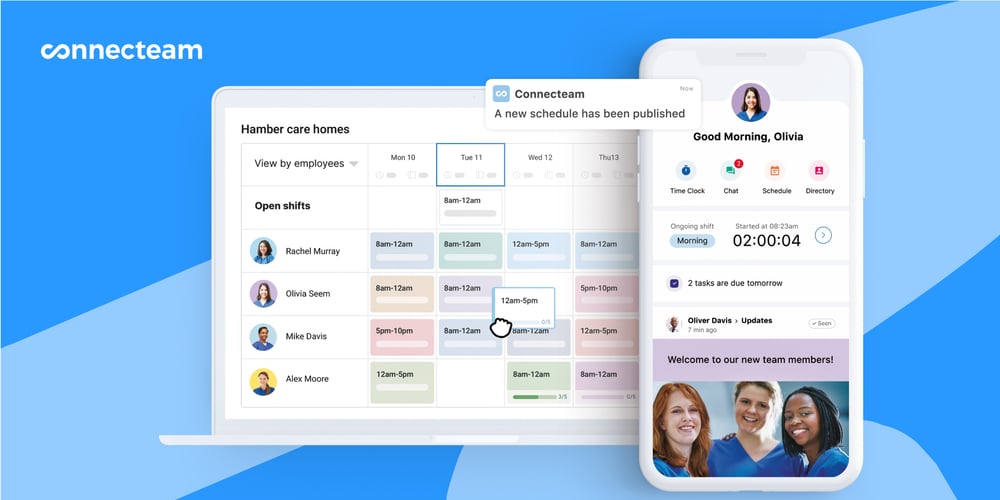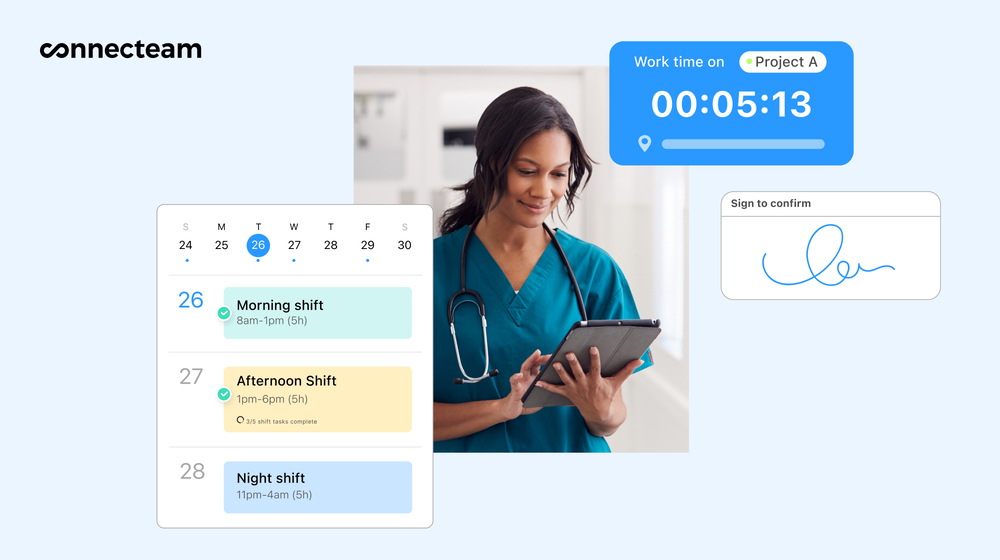NDIS rostering software makes scheduling easier for disability service providers. This guide covers key features of NDIS rostering software, how it can support your scheduling efforts and the 3 best NDIS scheduling platforms on the market.
Scheduling in the National Disability Insurance Scheme (NDIS) sector means considering client needs, staff availability, sudden changes and strict compliance.
Without the right tools, mistakes can lead to poor care and staff burnout. NDIS rostering software streamlines the process.
This guide covers how it works and highlights the top 3 platforms, including: Connecteam, Brevity and Schedulo.
Key Takeaways
- NDIS rostering software simplifies creating, assigning and managing workers’ schedules based on client requirements, staff availability and compliance regulations.
- Key features of NDIS rostering software include advanced scheduling, customisable rosters, time tracking, real-time updates, reporting, communication and integration with popular payroll software.
- In addition to simplifying scheduling, NDIS rostering software can help you increase productivity, enhance compliance, improve communication, provide quality care and ensure client and staff satisfaction.
What Is NDIS Scheduling Software?
NDIS stands for National Disability Insurance Scheme, a social welfare program in Australia that provides support and services to people with disabilities, their families and carers.
NDIS scheduling software is specialised, designed to meet the unique needs and challenges of NDIS providers.
It helps providers manage dynamic rosters, comply with the NDIS Quality and Safeguards Commission standards and deliver high-quality, person-centred care. Some platforms also include time tracking, reporting and communication features to simplify operations further.
Key Features of NDIS Rostering Software
These are the specific features you should look for in NDIS rostering software:
- Seamless integrations: You should be able to to integrate with the software you use most, such as payroll, EHR and CRM systems.
- Advanced scheduling: The software should support drag-and-drop builders, shift templates and tools for split shifts, recurring appointments and last minute changes.
- Customisable rosters: Managers must be able to build group, individual or on-call rosters and assign staff by skills, availability and client demand.
- Employee self-service: Staff need to be able to request time off, pick up open shifts and update availability.
- Real-time notifications: The tool should automatically send push alerts for shift changes, reminders and worker availability.
- Time and attendance tracking: Staff must be able to clock in and out directly in the app; manager should be able to verify attendance and hours worked in real-time.
- Communication tools: The software should have in-app messaging or third-party integrations for fast, mobile-friendly communication.
- Reporting and analytics: There needs to be insights on labour costs, productivity and client outcomes for data-driven decisions.
How much does NDIS rostering software cost?
The price of NDIS rostering rostering software depends on the features, the number of users, and whether you pay monthly or annually. Basic plans with scheduling and time tracking can around $2–$5 per user per month, and mid-tier plans with analytics and integrations can cost $6–$15 per user per month.
While these prices may not seem like much, they can add up fast, especially for larger teams. Advanced and enterprise-level packages can cost even more, but they may come with advanced compliance tools or unlimited support.
How NDIS Rostering Software Simplifies Scheduling
NDIS rostering software helps your scheduling by automating rosters, managing staff shifts and ensuring compliance. Other benefits include:
Faster rostering
NDIS rostering software lets you quickly create schedules using templates for recurring or one-off shifts. The software factors in staff availability, skills and qualifications and allows employees to claim open shifts. Last-minute changes are easier to manage, ensuring continuous client care.
Optimised staff allocation
Specialised software allows you to match workers to clients based on skills, preferences and care needs. This improves service quality, balances workloads, reduces burnout and supports NDIS compliance.
Minimised conflicts
NDIS rostering software detects double bookings, overtime and overlapping shifts. Alerts let you fix issues in real time to improve staff satisfaction and continuity of care.
Tracked attendance and redeployments
Digital clock-ins and GPS verification provide real-time visibility into attendance. You can fill missed shifts quickly and nearby staff can easily be redeployed in emergencies.
Improved communication
Staff receive instant notifications for new rosters or changes. Built-in messaging tools keep everyone connected, making last-minute adjustments smoother to ensure caregivers are always prepared.
Better compliance
Built-in rules around qualifications, certifications and hours help you stay aligned with NDIS standards. Software lets you securely store records of shifts, hours and staff credentials for audits and future reference.
The 3 Best NDIS Scheduling Software Platforms
Connecteam – Best all-in-one NDIS scheduling software

Connecteam is an all-in-one employee management platform that’s built to support NDIS service providers.
Smart scheduling and rostering
Connecteam’s drag-and-drop employee scheduler makes building and managing rosters simple. You can assign shifts based on staff qualifications, set recurring schedules, or publish open shifts for employees to claim. Connecteam’s auto-scheduler uses AI to instantly create fair rosters based on employee, availability, role, preferences, and qualifications. Shift-swapping is also built in, so workers can easily cover for each other. Connecteam factors in breaks, overtime, and approved leave, helping you prevent errors before schedules go live.
Attendance and time tracking
Connecteam’s employee time clock lets staff clock in and out from their mobile devices, while the real time GPS tracker verifies their on-the-job locations. Managers can easily monitor attendance, absences, overtime and even missed breaks in real time. Plus, all hours are automatically logged into timesheets for payroll. Connecteam integrates with popular payroll platforms, including MYOB, Xero, RUN Powered by ADP® and QuickBooks, so you don’t have to do double the work.

Communication and compliance
Connecteam also offers an in-app online team chat for one-on-one or group messaging, allowing staff to stay in touch and receive updates on rosters or last-minute changes in real-time. With secure document storage and reporting, you can be sure that your records are always secure and up to NDIS standards.
Price:
Connecteam offers a 14–day free trial and a Small Business Plan, which is completely free for up to 10 users. Paid plans use a flat rate and include up to 30 users:
| Plan | Users | Price |
| Basic | Up to 30 users | $29/month |
| Advanced | Up to 30 users | $49/month |
| Expert | Up to 30 users | $99/month |
Additional users can be added for an extra cost per user. For more information, check the pricing page.
Brevity – Good for multi-client rostering
Brevity is a cloud-based NDIS management system designed to help Australian disability service providers manage their operations more efficiently.
Schedule board
Brevity’s Schedule Board gives you a calendar-style view of your services, displayed by week, fortnight, or month. From here, you can see your entire roster at a glance. A handy Quick Actions tool lets you make bulk changes in just a few clicks, cutting down on repetitive admin and making day-to-day scheduling smoother.
Group and individual scheduling
One standout feature is Brevity’s ability to create Group Schedules. You can build rosters for multiple clients at once or tailor them for individual clients. The system also tracks caregiver availability, helping you match the right staff to the right shifts and build rosters that align with both client needs and workforce capacity.
Limitations to consider
While Brevity is powerful, it isn’t perfect. The platform comes with a noticeable learning curve, and its customisation and reporting options are limited compared to some competitors. These drawbacks may require extra time to adapt and could leave advanced users wanting more flexibility.
Price:
- Starts at $64.90/month for up to 10 clients
- Free trial available: Yes – 30-day
- Free plan: No
Skedulo – Good for integrating with Salesforce
Skedulo is a scheduling system for NDIS and consumer-directed care (CDC) providers.
Intelligent rostering
Skedulo uses AI automations to schedule staff based on availability, skills, and location. You can also roster multiple staff members to the same client or group of clients, making it easier to cover complex care needs.
Integrations and leave management
Skedulo integrates with Salesforce and offers robust APIs for custom workflows. Managers can also handle employee leave and unavailability through the mobile app. However, the app can sometimes feel slow, and Skedulo doesn’t offer a free plan, which could be potential drawbacks for smaller providers.
On-site care and compliance
Skedulo supports NDIS/CDC and in-home health by giving workers mobile access to customer history, custom forms, and data views. It also tracks compliance, ensuring staff have the required qualifications and clients receive the services they’re entitled to.
Price:
- Contact vendor for price
- Free trial available: No
- Free plan: No
The Bottom Line
NDIS rostering software enables you to create schedules that meet client requirements, work well for your caregivers, enhance client satisfaction and ensure compliance with NDIS guidelines.
There are various NDIS software platforms available, Connecteam stands out as the best option. It helps simplify scheduling with features like advanced scheduling, time and attendance tracking, communication tools, compliance management, reporting and more.
Get started with Connecteam for free today!
FAQs
What are the common challenges of implementing NDIS rostering software?
Challenges include staff resistance, data migration and integration issues with payroll or billing systems. Initial training needs and setup costs can also lead to slow adoption.
How does NDIS rostering software ensure compliance with regulations?
NDIS rostering software ensures compliance by recording staff qualifications, monitoring working hours and automating NDIS billing codes. It also reduces human error and generates reports for audits.
What are the security and privacy considerations for NDIS rostering software?
Key considerations include encryption of sensitive client data, secure cloud storage, role-based access for staff and compliance with Australian Privacy Principles.
What is the typical ROI of implementing NDIS rostering software?
ROI comes from reducing admin hours, minimising compliance errors, filling shifts faster and speeding up NDIS claim submissions.
What is the implementation timeline for NDIS rostering software?
Implementation depends on the software and organisation size. It can sometimes take 4–8 weeks, covering data migration, staff training and integration with payroll or CRM systems.
What level of staff training is required for NDIS rostering software?
Most staff need 1–2 weeks of guided training and practice. Platforms like Connecteam simplify onboarding with mobile-friendly tutorials, in-app training modules, and ongoing support, ensuring both carers and admins quickly learn compliance, scheduling, and reporting functions.
What are the key performance indicators (KPIs) for measuring the success of NDIS rostering software?
Important KPIs include roster accuracy, shift fill rate, time spent on scheduling, compliance error frequency, billing turnaround, and staff or client satisfaction scores.
What is the ongoing maintenance and support required for NDIS rostering software?
Ongoing support includes software updates, system monitoring, retraining staff, and access to customer service. Compliance checks and periodic feature upgrades ensure long-term efficiency.



